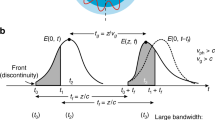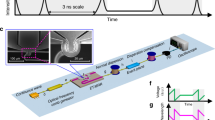Abstract
The ability to render objects invisible using a cloak (such that they are not detectable by an external observer) has long been a tantalizing goal1,2,3,4,5,6. Here, we demonstrate a cloak operating in the near infrared at a wavelength of 1,550 nm. The cloak conceals a deformation on a flat reflecting surface, under which an object can be hidden. The device has an area of 225 µm2 and hides a region of 1.6 µm2. It is composed of nanometre-size silicon structures with spatially varying densities across the cloak. The density variation is defined using transformation optics to define the effective index distribution of the cloak.
This is a preview of subscription content, access via your institution
Access options
Subscribe to this journal
Receive 12 print issues and online access
$209.00 per year
only $17.42 per issue
Buy this article
- Purchase on Springer Link
- Instant access to full article PDF
Prices may be subject to local taxes which are calculated during checkout





Similar content being viewed by others
References
Alú, A. & Engheta, N. Achieving transparency with plasmonic and metamaterial coatings. Phys. Rev. E 72, 016623 (2005).
Miller, D. A. B. On perfect cloaking. Opt. Express 14, 12457–12466 (2006).
Alú, A. & Engheta, N. Plasmonic materials in transparency and cloaking problems: mechanism, robustness and physical insights. Opt. Express 15, 3318–3332 (2007).
Zhao, Y., Argyropoulos, C. & Hao, Y. Full-wave finite-difference time-domain simulation of electromagnetic cloaking structures. Opt. Express 16, 6717–6730 (2008).
Weder, R. A rigorous analysis of high-order electromagnetic invisibility cloaks. J. Phys. A 41, 065207 (2008).
Weder, R. The boundary conditions for point transformed electromagnetic invisibility cloaks. J. Phys. A 41, 415401 (2008).
Ward, A. & Pendry, J. Refraction and geometry in Maxwell's equations. J. Mod. Opt. 43, 773–793 (1996).
Leonhardt, U. & Philbin, T. G. General relativity in electrical engineering. New J. Phys. 8, 247 (2006).
Pendry, J. B., Schurig, D. & Smith, D. R. Controlling electromagnetic fields. Science 312, 1780–1782 (2006).
Kildishev, A. V. & Shalaev, V. M. Engineering space for light via transformation optics. Opt. Lett. 33, 43–45 (2008).
Tyc, T. & Leonhardt, U. Transmutation of singularities in optical instruments. New J. Phys. 10, 115038 (2008).
Leonhardt, U. Optical conformal mapping. Science 312, 1777–1780 (2006).
Cummer, S. A., Popa, B., Schurig, D., Smith, D. R. & Pendry, J. Full-wave simulations of electromagnetic cloaking structures. Phys. Rev. E 74, 036621 (2006).
Hendi, A., Henn, J. & Leonhardt, U. Ambiguities in the scattering tomography for central potentials. Phys. Rev. Lett. 97, 073902 (2006).
Cai, W., Chettiar, U. K., Kildishev, A. V. & Shalaev, V. M. Optical cloaking with metamaterials. Nature Photon. 1, 224–227 (2007).
Ruan, Z., Yan, M., Neff, C. W. & Qiu, M. Ideal cylindrical cloak: perfect but sensitive to tiny perturbations. Phys. Rev. Lett. 99, 113903 (2007).
Chen, H., Wu, B., Zhang, B. & Kong, J. A. Electromagnetic wave interactions with a metamaterial cloak. Phys. Rev. Lett. 99, 063903 (2007).
Huang, Y., Feng, Y. & Jiang, T. Electromagnetic cloaking by layered structure of homogeneous isotropic materials. Opt. Express 15, 11133–11141 (2007).
Silveirinha, M. G., Alu, A. & Engheta, N. Parallel-plate metamaterials for cloaking structures. Phys. Rev. E 75, 036603 (2007).
Li, J. & Pendry, J. B. Hiding under the carpet: a new strategy for cloaking. Phys. Rev. Lett. 101, 203901 (2008).
Alú, A. & Engheta, N. Multifrequency optical invisibility cloak with layered plasmonic shells. Phys. Rev. Lett. 100, 113901 (2008).
Jiang, W. X. et al. Analytical design of conformally invisible cloaks for arbitrarily shaped objects. Phys. Rev. E 77, 066607 (2008).
Leonhardt, U. & Tyc, T. Broadband invisibility by non-Euclidean cloaking. Science 323, 110–112 (2009).
Schurig, D. et al. Metamaterial electromagnetic cloak at microwave frequencies. Science 314, 977–980 (2006).
Liu, R. et al. Broadband ground-plane cloak. Science 323, 366–369 (2009).
Valentine, J., Li, J., Zentgraf, T., Bartal, G. & Zhang, X. An optical cloak made of dielectrics. Nature Mater. 8, 569–571 (2009).
Nakamura, T., Shimizu, M., Kimura, H. & Sato, R. Effective permittivity of amorphous mixed materials. Electron. Commun. Jpn. 1 88, 1–9 (2005).
Knupp, P. M. & Steinberg, S. Fundamentals of Grid Generation (CRC Press, 1993).
Thompson, J. F., Soni, B. K. & Weatherill, N. P. Handbook of Grid Generation (CRC Press, 1998).
Shalaev, V. M. Physics: transforming light. Science 322, 384–386 (2008).
Acknowledgements
The authors would like to acknowledge the support of Cornell's Center for Nanoscale Systems (CNS), funded by the National Science Foundation. This work was performed in part at the Cornell Nanoscale Facility, a member of the National Nanotechnology Infrastructure Network, which is supported by the National Science Foundation.
Author information
Authors and Affiliations
Contributions
L.H.G. designed and simulated the devices. L.H.G. and J.C. carried out the fabrication of the samples. L.H.G. and C.B.P. conducted the experiments. L.H.G., C.B.P. and M.L. designed the experiments and discussed their results and implications.
Corresponding author
Rights and permissions
About this article
Cite this article
Gabrielli, L., Cardenas, J., Poitras, C. et al. Silicon nanostructure cloak operating at optical frequencies. Nature Photon 3, 461–463 (2009). https://doi.org/10.1038/nphoton.2009.117
Received:
Accepted:
Published:
Issue Date:
DOI: https://doi.org/10.1038/nphoton.2009.117
This article is cited by
-
A conformal mapping approach to broadband nonlinear optics on chip
Nature Photonics (2024)
-
Low profile multi-layered invisibility carpet cloak using quantum dot core–shell nanoparticles
Scientific Reports (2023)
-
3D printing metamaterials for highly efficient electromagnetic wave absorption
Science China Materials (2023)
-
Broadband continuous supersymmetric transformation: a new paradigm for transformation optics
eLight (2022)
-
Volumetric metamaterials versus impedance surfaces in scattering applications
Scientific Reports (2021)



